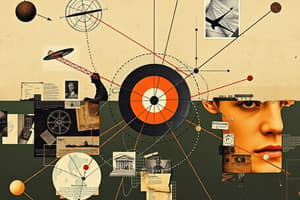Podcast
Questions and Answers
What experimental evidence conclusively established the particle behavior of light?
What experimental evidence conclusively established the particle behavior of light?
- Interference patterns
- The photoelectric effect (correct)
- Diffraction patterns
- Polarization of light
Which phenomena provide exclusive evidence for the wave behavior of light?
Which phenomena provide exclusive evidence for the wave behavior of light?
- Polarization and Compton scattering
- Interference and diffraction (correct)
- The photoelectric effect
- Compton scattering
In what way does light exhibit wave-particle duality?
In what way does light exhibit wave-particle duality?
- As a collection of particles in all phenomena
- As a continuous wave in some phenomena and as a flux of particles in others
- As a continuous wave in all phenomena
- As an advancing wave in some phenomena and as a flux of particles in others (correct)
What did de-Broglie's hypothesis propose about the nature of radiation?
What did de-Broglie's hypothesis propose about the nature of radiation?
What is the key idea behind de-Broglie's hypothesis?
What is the key idea behind de-Broglie's hypothesis?
Flashcards are hidden until you start studying
Study Notes
Experimental Evidence for Particle Behavior of Light
- The conclusive experimental evidence was provided by Albert Einstein's photoelectric effect experiment in 1905, which showed that light can behave as particles (photons) under certain conditions.
Exclusive Evidence for Wave Behavior of Light
- The phenomena that provide exclusive evidence for the wave behavior of light include:
- Interference (e.g., Young's double-slit experiment)
- Diffraction
- Superposition
Light's Wave-Particle Duality
- Light exhibits wave-particle duality, meaning it can exhibit both wave-like and particle-like behavior depending on how it is observed.
de-Broglie's Hypothesis
- In 1924, Louis de Broglie proposed that all radiation, including light, can exhibit wave-like behavior.
- The key idea behind de Broglie's hypothesis is that particles, such as electrons, can exhibit wave-like behavior, and vice versa.
Studying That Suits You
Use AI to generate personalized quizzes and flashcards to suit your learning preferences.




